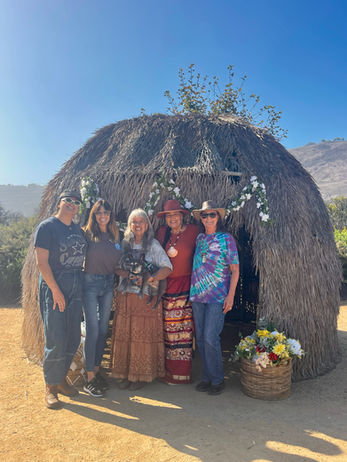Celebrate Native Heritage Month With Us!
Led by
Georgia “Chena” Edmundson
Frank Barraza
Members at Large on Tribal Council

Celebrate Native Heritage Month with
the Juaneño Band of Mission Indians Acjachemen Nation
Sunday, November 9, 2025
9:00 AM – 11:00 AM
Village of Putuidem, San Juan Capistrano
Join us for a special Cultural Day in honor of Native Heritage Month
Experience a morning of learning, connection and community with
members of the Acjachemen Nation.
Enjoy native food, a traditional blessing and a hands-on cultural project
celebrating Indigenous traditions and teachings.
🌾What to Expect
-
Opening Blessing by an Acjachemen Elder
Cleanse the space and set a peaceful, welcoming tone with a traditional blessing rooted in ancestral wisdom. -
Sage Bundle Workshop
Led by Cultural Educator ; this hands-on experience explores:-
The cultural and spiritual significance of sage
-
When and how to responsibly harvest white sage
-
The importance of offering gratitude to the plant
-
How seasons affect sage’s potency and aroma
-
Techniques for crafting your own smudge bundle
-
🌿Leave with More Than a Bundle
Each guest will take home a handmade sage smudge stick and a deeper understanding of how sage represents respect, healing and connection to the Earth and ancestors.
This event is an opportunity learn and honor Indigenous traditions in a
meaningful and respectful way.
Food, Culture & Resilience
Fry bread holds a story much deeper than its golden, crispy surface.
It was born out of survival, created by Native peoples who were displaced from their lands and forced to rely on government-issued rations.
With simple ingredients like flour, salt, and lard, they turned scarcity into sustenance, resilience and tradition.
Today, fry bread represents both strength and remembrance.
For many, it symbolizes resourcefulness, creativity and cultural pride, a way to honor the ancestors who endured hardship while keeping their communities nourished and connected.
For others, it stands as a reminder of the painful history of colonization and loss of traditional foods.
Each piece of fry bread carries its own story, shaped by the hands and hearts that make it.
Acknowledging its full history, both the struggle and the spirit, allows us to appreciate this cherished food as a powerful symbol of endurance, identity and the unbroken connection between people, culture and the land.

Fry Bread Recipe
A simple, beloved recipe shared in honor of Native traditions and resilience.
Every tribe and family has its own way of making fry bread. This version is shared to celebrate the creativity and endurance of Native peoples who transformed limited ingredients into a symbol of strength and community.
Yield: about 6 pieces (adjust as needed)
Prep + rest time: ~30 min
Fry time: ~10 min
Ingredients
-
2 cups all-purpose flour
-
1 tablespoon baking powder
-
½ teaspoon salt
-
1 cup warm water (add slowly; you may not need it all)
-
Oil for frying (vegetable or another neutral oil)
Instructions
-
Mix the flour, baking powder, and salt in a medium bowl.
-
Add warm water a little at a time until the dough forms a soft, slightly sticky ball.
-
Rest the dough for about 15–20 minutes, covered with a clean towel.
-
Shape into small balls (about golf-ball size) and flatten into rounds about ¼ inch thick.
-
Heat 1–2 inches of oil in a skillet to 350–375°F.
-
Fry each round until golden brown on both sides, about 2–3 minutes per side.
-
Drain on paper towels and enjoy warm — plain, with honey or jam, or as a base for savory toppings.
We honor the Juaneño Band of Mission Indians Acjachemen Nation, whose stories, teachings and community spirit continue to inspire our understanding of food, land and heritage.
The Sacred Practice of Burning Sage

Before ceremonies or gatherings, members of the Juaneño Band of Mission Indians Acjachemen Nation, often
begin with a blessing that includes burning sage.
This sacred practice helps set a tone of respect and connection to the land, the ancestors and one another.
Burning sage often called smudging is a sacred ceremony practiced by many Indigenous peoples, including the Juaneño Band of Mission Indians, Acjachemen Nation (JBMIAN).
It is a way to cleanse a space, person, or object of negative energy and to invite peace, clarity and connection with the Creator.
For the Acjachemen people, the smoke from the sage carries prayers to the heavens. It is used in blessings, gatherings and cultural ceremonies to honor the land, ancestors and the spiritual world.
The act itself is one of mindfulness and gratitude, reminding us to move through life with respect for all living things.
When sage is burned, participants may gently fan the smoke toward their hearts and heads, symbolizing the cleansing of thoughts and intentions. It’s more than a ritual it’s a moment to pause, reflect and reconnect with the natural world and our shared responsibility to care for it.
“When we smudge, we’re purifying not just the air around us but our spirit within.” — Acjachemen teaching







